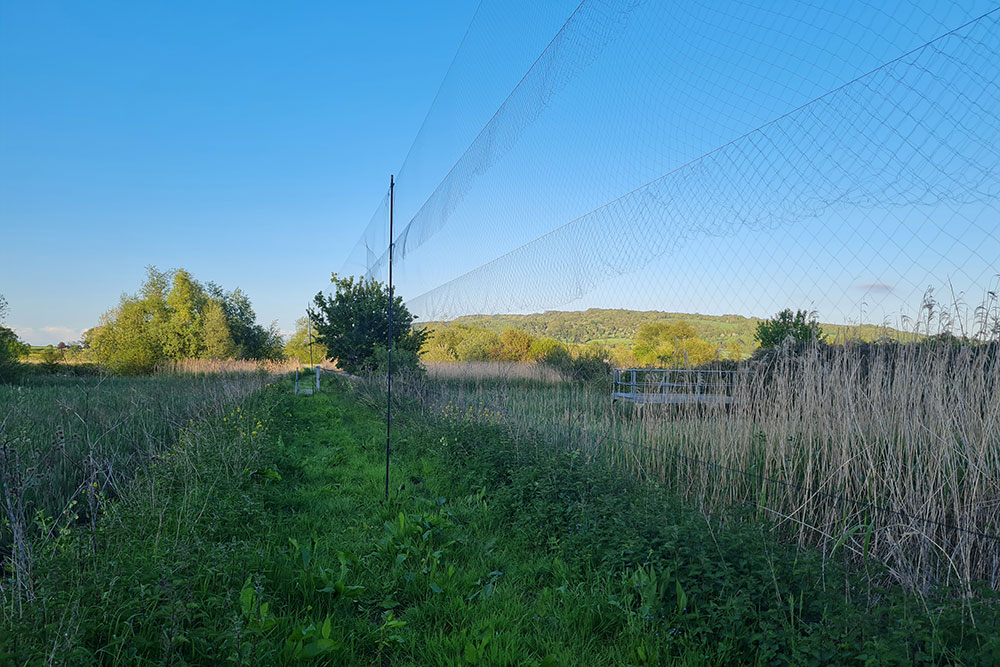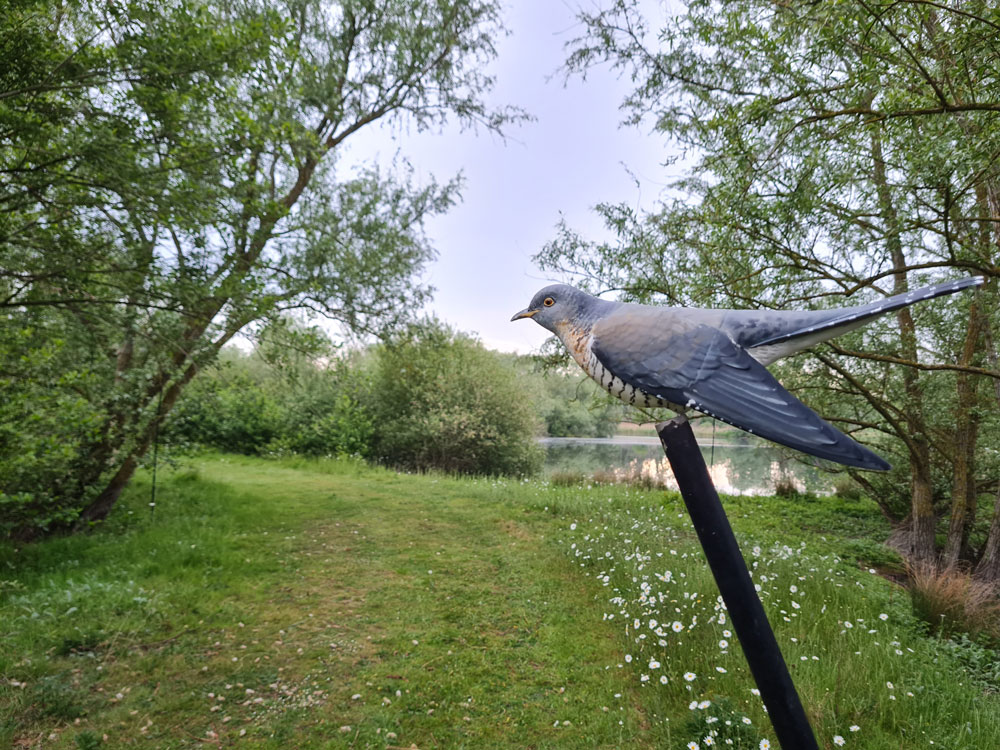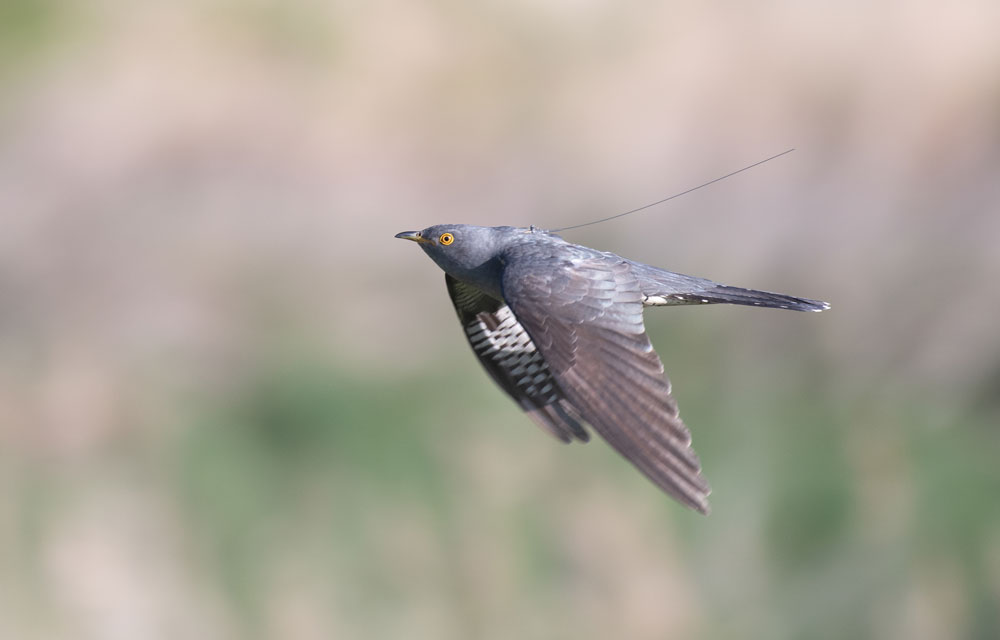
Spring is fantastically busy for everyone involved in the Cuckoo Tracking Project. There’s definitely some anticipation that builds up at this time of year, when we’re preparing for the fieldwork, but that is usually overridden by being busy with plans and logistics – and knowing that the pressure is on to get the tags successfully deployed!
We usually aim to catch and tag Cuckoos in a few different locations around the UK each year, which means the fieldwork team – usually myself, Lee Barber and Phil Atkinson – has to split up. It’s not unusual to have some unsuccessful catching mornings, and the window of time when the Cuckoos can be caught is fairly short, so it definitely pays to be in more than one place at once.
This year Phil and I are heading to Scotland while Lee starts coverage of our long-running sites in Norfolk, Sussex and Worcestershire.

Into the field
The mist net used for catching Cuckoos, set up at Strensham, Worcestershire in 2023.
Even with more than a decade of experience under our belts, catching and tagging Cuckoos can be a tricky business. We still use our tried and tested large-mesh fine mist nets, which we tempt male birds into using a tape recording of both male and female birds in a mating frenzy!
This tape stimulates male interest in the potential female ‘mate’ and rivalry against his imaginary male competitors. If there’s a real live female around, though, there’s no contest – we usually have a number of fruitless catching sessions where males spend all their time chasing actual female birds and take little notice of our set-up.
Success really depends on understanding the conditions in which the birds respond best to the recording, and knowing the best net and recording placements for different situations. We’ve also realised it’s not worth targeting birds that have been exposed to the recordings before (they seem to learn quite quickly!) and then, as with anything, we need a bit of luck!
During the catching session, there’s a nervous excitement during the wait whilst we watch and see what happens as birds begin to respond to the recording. Then there’s a rushed moment of euphoria once a bird has gone in, and we make a beeline for the nets to extract it before it manages to extract itself and fly off! But then the preoccupation with getting the tag on properly and the bird released takes over, and we work as quickly as we can to do this safely.
For me, the best part of tagging a Cuckoo is always and has always been releasing it – this can be a moment of relief, pride or joy (depending on circumstances), seeing it fly off strongly with the tag in place.
Lee Barber releasing a tagged Cuckoo in Killarney National Park, Ireland, in 2023.

What’s new this year?
Our new female Cuckoo lure – a painted 3D-printed model.
We’ll be catching near Ullapool (Ross and Cromarty, Scottish Highlands), which will be our most north-westerly tagging location yet. This will help us get a better understanding of the survival rates of birds from the uplands to compare with that of birds from the lowlands. We’ve done a lot of research on Cuckoo migration routes already, so the idea is to see how breeding habitat and migration route interact to impact the birds’ survival throughout the year.
We’re going to continue experimenting with our new female Cuckoo lure – a painted 3D-printed model rather than a stuffed bird – to see how successful it is at bringing the males to the net. We’ll also be starting a trial of a different type of tracking tag (a GPS tag that downloads over the mobile phone network rather than a satellite tag), which will give us much finer-scale information about the habitats the Cuckoos use in different parts of the UK and in other locations throughout their annual cycle. This information will also help us work out how the type of habitat used by the Cuckoos is linked to their survival on migration.
The ultimate aim of this work is to understand how we can provide better quality habitat here in the UK to aid the Cuckoos’ survival – that is, to provide habitats full of caterpillars with which they can fuel their breeding efforts and migrations – and help reverse their huge population declines.

Looking back …
Our Cuckoo tagging work with Birding Beijing revealed an extraordinary Cuckoo migration across Asia, over the Indian Ocean and into south-east Africa for the first time. At over 10,000 km, this is one of the longest migrations documented for any land bird.
It’s quite incredible to look back to 2011 when the project started, and to see how much we’ve learnt since then, and how much the project has developed. We’ve made discoveries about the Cuckoo and bird migration in general that are new to science, collaborated with other tracking researchers in Mongolia, China, Germany and Belarus, and engaged thousands of people across the globe with the migration and conservation of these spectacular birds. It’s been quite a journey, and one that’s only been possible because of the incredible support from all our Cuckoo sponsors and tag donors.
Of course, we’ve had to change plans occasionally. For example, we originally wanted to include female birds in our study, to compare how their migration differed from that of the males. But it turned out that females are really hard to catch! They require much more background preparation than males for us to catch them reliably, mapping out their laying territories in advance, and this just wasn’t feasible most of the time.
Rarely, we do catch a female bird, but we don’t tag them (although long-standing followers of the project may remember Idemili, the only female bird we have ever tagged). This is mainly because the majority of birds we catch are males, and sticking to this means we don’t have to split our sample size (the number of tagged birds) by sex when we conduct our analyses. Our results are more robust this way, but we’re hoping we will be able to include female birds in the project once we start to use the GPS tags we are trialling this year.
The tracking tags themselves have also changed a bit since the project started. They are now about 20% lighter than they were originally, partly due to them having a thinner antenna. This reduces the tag weight, and also any aerodynamic impact of the antenna as the Cuckoo is flying. That might be especially important as they cross the Sahara. And of course, this year is the first year we’ll be trialling the GPS tags as well as the satellite tags.
To make absolutely sure that there’s no chance of the harness that holds the tag in place becoming frayed, we use a superglue accelerator and epoxy resin to carefully secure the harness knots when we attach the tags to the birds.
Lee Barber explains how the satellite tags used in the project work.

… and looking forward
This is the 13th year that BTO has tagged and tracked Cuckoos on their migratory journeys (it’s the 14th year since we began but no tagging took place in 2021 due to the COVID-19 pandemic), and people do sometimes ask us: why do you need this project to continue? After all, 14 years of data seems like quite a lot. Why do we need more?
Well, the fact that the project has been going on so long is its key strength: any changes to the trends in Cuckoo survival are immediately apparent because we’ve got such a strong baseline to compare them with. This is especially true now because the project is the only long-term study of Afro-Palearctic bird migration that currently exists. Also, the number of birds we have tracked in any one year is quite small, and the larger our sample size, the more robust our conclusions.
It might seem like it’s just a data-gathering exercise, but these data can have a real impact. Understanding how environmental conditions are impacting these birds through their annual cycle enables us to work out how best to help them – which we need to do with increasing urgency, as the species is still Red-listed and declining in the UK.
Based on what we learn, we constantly reappraise the focus of our research, from the impact of the drought-busting rains in the Inter-Tropical Convergence Zone in West Africa, to the genetics that underpin the Cuckoos’ choice to take a south-westerly or south-easterly route on their post-breeding migration. Soon, we’ll be focusing on the Cuckoos’ habitat use, so we can better inform conservation measures in key regions.
Beyond that, the project continues to engage the public, who can watch the migrations of the birds and this research unfold in virtually real-time. That can only help to raise awareness of their plight and the amazing migrations they undertake each year.

Sponsor a Cuckoo and support the project
Becoming a sponsor is quick, easy and rewarding, and you can even give Cuckoo sponsorship as a gift.
“I have been following the progress of all the Cuckoos, and more specifically AJ whom I sponsored, for many weeks now and I wanted to let you know how much pleasure it has given me. What a feat for such plucky little birds! They are incredible. I will continue to track them all.”

